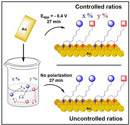Publication
803
ChemElectroChem,, 3 (9), 1422-1428, 2016
DOI:10.1002/celc.201600260
|
|
|
|
|
|

|
Electro-assisted deposition of binary self-assembled 1,2-dithiolane monolayers on gold with predictable composition
|
|
|
|
Dany Capitao, Rihab Sahli, Noureddine Raouafi, Benoit Limoges, Claire Fave, and Bernd Schöllhorn
Laboratoire d’Electrochimie Moléculaire, UMR 7591 CNRS Université Paris Diderot, Sorbonne Paris Cité,, 15 rue Jean-Antoine de Baïf, 75205 Paris Cedex 13, France
Laboratoire de Chimie Analytique et d’Electrochimie, Département de Chimie, Faculté des Sciences de Tunis, Université El-Manar, 2092 Tunis El-Manar, Tunisia
The design of highly efficient and selective photocatalytic systems for CO2 reduction that are based on nonexpensive materials is a great challenge for chemists. The photocatalytic reduction of CO2 by [Co(qpy)(OH2)2]2+ (1) (qpy = 2,2':6',2":6",2"'-quaterpyridine) and [Fe(qpy)(OH2)2]2+ (2) have been investigated. With Ru(bpy)32+ as the photosensitizer and 1,3-dimethyl-2-phenyl-2,3-dihydro-1H-benzo[d]imidazole as the sacrificial reductant in CH3CN/triethanolamine solution under visible-light excitation (blue light-emitting diode), a turnover number (TON) for CO as high as 2660 with 98% selectivity can be achieved for the cobalt catalyst. In the case of the iron catalyst, the TON was >3000 with up to 95% selectivity. More significantly, when Ru(bpy)32+ was replaced by the organic dye sensitizer purpurin, TONs of 790 and 1365 were achieved in N,N-dimethylformamide for the cobalt and iron catalysts, respectively. |

